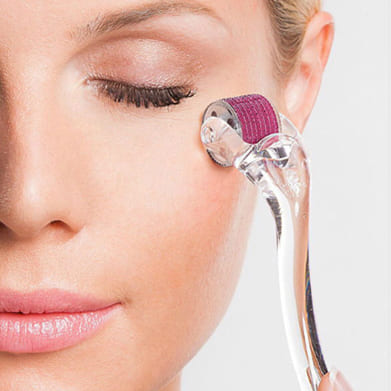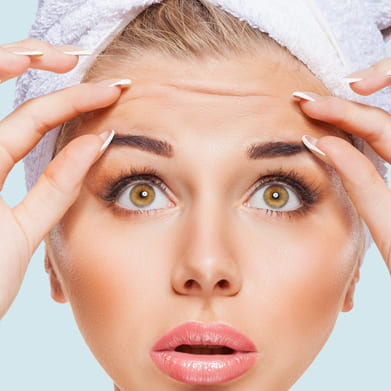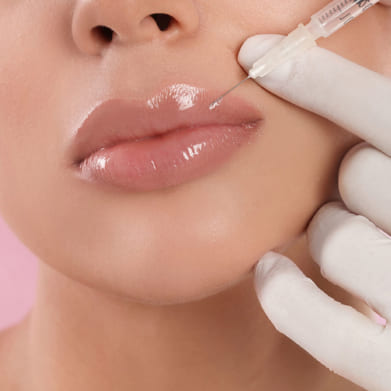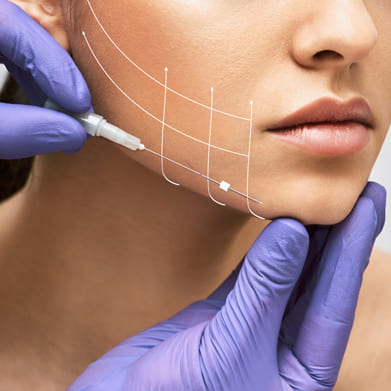Antiaging Treatement
All types of Antiaging Treatments are available in Skin 360 Clinic
Dermapen / Derma Roller
Dermapen and derma rollers are skincare devices used in microneedling procedures to improve the appearance of the skin. Here's a detailed explanation of both:

Derma Roller:
A derma roller is a handheld device with a cylindrical head covered in tiny, shallow needles. These needles, typically made of medical-grade stainless steel, puncture the skin when rolled over the treatment area. Derma rollers come in various needle lengths, ranging from 0.25 to 3 millimeters, with shorter needles used for superficial treatments and longer needles for deeper penetration.
Dermapen:
A dermapen is an advanced microneedling device that automates the process of creating micro-injuries in the skin. It consists of a pen-like device with a disposable cartridge containing multiple fine needles that oscillate rapidly to create controlled micro-channels in the skin.
Benefits:
- Precision and Consistency: The automated nature of the dermapen ensures consistent needle penetration and avoids uneven pressure or trauma to the skin.
- Customizable Treatment: The depth of needle penetration can be adjusted based on the specific skin concerns and treatment goals.
- Enhanced Safety: Dermapen reduces the risk of cross-contamination as it utilizes disposable needle cartridges for each treatment session.
- Versatility: Dermapen can be used on various areas of the face and body, including delicate areas like the under-eye area and lips.
In summary, both derma rollers and dermapens are effective tools for microneedling treatments, offering benefits such as improved skin texture, collagen induction, and enhanced product absorption. However, dermapens provide advantages in terms of precision, consistency, and customization, making them a preferred choice for many skincare professionals and patients.
Botox
Botox, short for Botulinum Toxin, is a neurotoxic protein produced by the bacterium Clostridium botulinum. Despite its toxic nature, when used in small, controlled doses, it has several medical and cosmetic applications.

Cosmetic Use:
Botox is primarily known for its cosmetic use in reducing the appearance of wrinkles and fine lines on the face. It works by temporarily paralyzing the muscles responsible for creating wrinkles, such as those around the eyes (crow's feet), forehead, and between the eyebrows (frown lines). By blocking nerve signals to these muscles, Botox smoothens the skin and creates a more youthful appearance.
Medical Uses:
- Treatment of Muscle Disorders: Botox is used to treat various medical conditions characterized by muscle spasms or excessive muscle activity. These include:
- Blepharospasm: Involuntary muscle contractions around the eye, causing uncontrollable blinking or spasms.
- Cervical Dystonia: A neurological disorder causing involuntary contractions of neck muscles, leading to abnormal head posture and neck pain.
- Hyperhidrosis: Excessive sweating in areas like the palms, soles of the feet, and underarms.
- Chronic Migraine Treatment: Botox injections are approved by the FDA for preventing chronic migraines in adults who experience migraines on 15 or more days per month.
Overall, Botox is a widely used and effective treatment for various cosmetic and medical conditions, but it's essential to consult with a qualified healthcare provider to determine if it's suitable for your specific needs and to ensure safe administration.
Fillers

Fillers, also known as dermal fillers or soft tissue fillers, are substances injected into the skin to add volume, fill in wrinkles, or enhance facial contours. Here's an in-depth explanation:
Types of Fillers:
- Hyaluronic Acid (HA) Fillers: The most common type, composed of a substance naturally found in the body that attracts and binds water molecules to add volume and hydration.
- Calcium Hydroxylapatite (CaHA) Fillers: Stimulate collagen production, providing longer-lasting results.
- Poly-L-lactic Acid (PLLA) Fillers: Also stimulates collagen production, gradually improving skin texture and volume over time.
- Polymethylmethacrylate (PMMA) Fillers: Semi-permanent fillers composed of tiny spheres suspended in a gel-like solution, providing long-lasting results.
- Autologous Fillers: Use the patient's own fat or tissue, harvested from another area of the body through liposuction, and injected into desired areas.
Overall, fillers offer a non-surgical solution to address signs of aging and enhance facial features, but it's crucial to consult with a qualified healthcare provider to ensure safe and satisfactory results.
Thread Lifting
Thread lifting is a minimally invasive cosmetic procedure designed to lift and tighten sagging skin on the face and neck. It involves the insertion of dissolvable sutures or threads under the skin to create a lifting effect. These threads are typically made of biocompatible materials such as polydioxanone (PDO) or polylactic acid (PLA), which stimulate collagen production and gradually dissolve over time.

The procedure begins with a consultation with a qualified healthcare provider or cosmetic surgeon to assess the patient's concerns and determine if they are a suitable candidate for thread lifting. During the procedure, the patient may receive local anesthesia to numb the treatment area, although some providers offer sedation or general anesthesia depending on the extent of the treatment and the patient's preferences.
Once the anesthesia has taken effect, the healthcare provider will carefully insert the threads into specific areas of the face or neck using a fine needle or cannula. The threads are strategically placed to lift and support the underlying tissues, resulting in a more youthful and rejuvenated appearance. Depending on the patient's needs, multiple threads may be inserted to achieve the desired results. After the threads are inserted, the provider may gently manipulate the skin to further enhance the lifting effect. Once the procedure is complete, any excess thread material is trimmed, and the treatment area is cleaned and bandaged if necessary.
Patients may experience some minor discomfort, swelling, or bruising after thread lifting, but these side effects typically subside within a few days to a week. Most patients are able to resume their normal activities immediately after the procedure, although strenuous exercise and excessive facial movements should be avoided for a short period to allow the threads to settle into place. The results of thread lifting are visible immediately, with further improvement in the weeks following the procedure as collagen production is stimulated and the threads gradually dissolve. While thread lifting can provide noticeable lifting and tightening effects, the results are not permanent and typically last anywhere from 1 to 3 years depending on the type of threads used and individual factors such as skin quality and aging process. It's important for patients considering thread lifting to have realistic expectations about the outcomes and to choose a qualified and experienced provider who can safely perform the procedure. As with any cosmetic treatment, there are potential risks and complications associated with thread lifting, including infection, thread migration, and asymmetry, so it's essential to discuss these with your provider before undergoing the procedure.